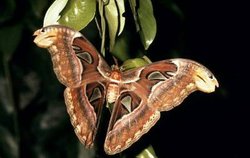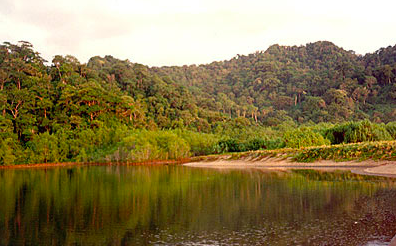Eastern Java-Bali rain forests
Introduction The Eastern Java-Bali Rain Forests are found on one of the most actively volcanic (Eastern Java-Bali rain forests) islands in the world. Once the home of the extinct Javan and Balinese tigers (Panthera tigris sondaicus and Panthera tigris balica, respectively), these forests still contain one of the most endangered and high-profile songbirds in the world, the Bali starling (Leucopsar rothschildi). Almost all of this ecoregion's natural habitat was cleared long ago by logging interests and for agriculture and settlements to provide for a rapidly expanding, dense human population. Only tiny fragments of natural forests remain, and these are also disturbed.
Location and General Description
This ecoregion represents the lowland moist forests of eastern Java and Bali in the Indonesian Archipelago. Based on the Köppen climate zone system, this ecoregion falls in the tropical wet and dry climate zones, although as one moves east on Java there is increasing seasonality of precipitation. Java probably did not exist before the Miocene (24 million years ago). Bali did not emerge until as recently as 3 million years ago. Truly born of fire, the islands of Java and Bali are the result of the subduction and remelting of the Australian-Indian Ocean tectonic plate beneath the Eurasian tectonic plate at the Java trench. The melted crust has risen as volcanoes and, along with subsequent sedimentation, created Java. Therefore, the surface geology consists of Tertiary and Quaternary volcanics, alluvial sediments, and areas of uplifted coral limestone. Twenty of the volcanoes on Java and Bali have been active in historic times, and they are among the most active volcanic islands in the world. During previous ice ages, when sea levels were much lower, Java and Bali were connected to Sumatra, Borneo, and the rest of the Asian mainland.
The climate in eastern Java and Bali is drier than in the western part of Java; therefore, the lowland forests are predominantly moist deciduous forests, with semi-evergreen rain forest along the south coast and dry deciduous forest along the north coast. No one family dominates the forests of Java, as is the case with the dipterocarps in Sumatra and Borneo.
Java and Bali's deciduous forests generally are lightly closed, with few trees exceeding 25 meters (m). Borassus and Corypha palms are good indicators of the seasonal climates that generate deciduous forests in the region. Moist deciduous forests have 1,500-4,000 millimeters (mm) of rainfall annually, with a four- to six-month dry season. Dry deciduous forests have less than 1,500 mm of annual rainfall and more than six dry months. Common lowland deciduous trees in eastern Java and Bali are Homalium tomentosum, Albizia lebbekoides, Acacia leucophloea, A. tomentosa, Bauhinia malabarica, Cassia fistula, Dillenia pentagyna, Tetrameles nudiflora, Ailanthus integrifolia, and Phyllanthus emblica. Many herbaceous plants are confined to the deciduous forests.
Semi-evergreen rain forest is slightly more seasonal than the evergreen rain forest found in western Java, with two to four dry months each year. The most common species in the rain forests of Java are Artocarpus elasticus (Moraceae), Dysoxylum caulostachyum (Meliaceae), langsat Lansium domesticum (Meliaceae), and Planchonia valida (Lecythidaceae). Little forest remains below 500 m in Bali, so the natural forest composition is somewhat unclear, but trees commonly found in the remnants of Bali's lowland rain forests include Dipterocarpus hasseltii, Planchonia valida, Palaquium javense, Duabanga moluccana, Meliosma ferruginosa, Pterospermum javanicum, and Tabernaemontana.
Limestone forests on Java and Bali have basal areas similar to those of other lowland forest types and apparently contain no plant endemics, but because they often grow on steep slopes of shallow soils, their growth pattern is affected. Limestone forests are found on Nusu Barung and Nusa Penida.
Biodiversity Features
 Atlas Moth (Attacus atlas) Java, Indonesia. (Source: Photograph by WWF-Canon / Alain Compost)
Atlas Moth (Attacus atlas) Java, Indonesia. (Source: Photograph by WWF-Canon / Alain Compost) The overall richness and endemism for this ecoregion are low to moderate when compared with those of other ecoregions in Indo-Malaysia.
The ecoregion harbors 103 mammal species. The Kangean Islands, off the northern coast of Java, have uplifted limestone deposits with numerous caves that harbor fourteen of these islands' fifteen bat species. Fruit bats play an exceptionally important ecological role by pollinating and dispersing plants. Of special significance is the cave fruit bat (Eonycteris spelaea), which is a pollinator of the economically important durian tree (Durio zibethinus). The endangered Bawean (or Kuhl's) deer (Axis kuhlii), confined to the small island of Bawea, is a strict endemic of this ecoregion (Table 1). The other endemic mammal is the vulnerable Javan warty pig (Sus verrucosus). Additional mammal species of conservation significance are the endangered Javan yellow-throated marten (Martes flavigula robinsoni) and banteng (Bos javanicus). The Javan subspecies of leopard on Java (Pantera pardus melas) is also considered endangered. Two tiger subspecies, the Javan and Balinese tigers (Panthera tigris sundaica and Panthera tigris balica, respectively), once inhabited these islands but are now extinct. The Balinese tiger disappeared by the end of World War II, but reports of Javan tigers persisted into the 1970s in the southeast.
|
Table 1. Endemic and Near-Endemic Mammal Species. Family Species Suidae Sus verrucosus Cervidae Axis kuhlii* *An asterisk signifies that the species' range is limited to this ecoregion. This ecoregion (Eastern Java-Bali rain forests) harbors almost 350 bird species, including ten endemic and near-endemic species (Table 2). This ecoregion overlaps partially with the Java and Bali forests and Javan coastal zone Endemic Bird Areas (EBAs). Together these two EBAs contain thirty-seven restricted-range bird species, only some of which are found in the lowlands of this ecoregion. Included are the critically endangered Bali starling (Leucopsar rothschildi) and the endangered Javan hawk eagle (Spizaetus bartelsi). Current Status
| ||||||||

